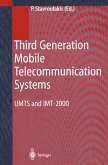It took more than 15 years of research, standardization work, and develop ment with an enormous effort of manpower to bring third generation (3G) wireless communication systems to life. The first research work on 3G sys tems started around 1988 [1]. At this time the striking success of second generation (2G) systems, especially of GSM (Global System for Mobile Com munications), was not yet evident. A substantial part of these early research activities took place in Europe and was sponsored by the European Commis sion in the course of research programs such as: Research and Development of Advanced Communications Technologies in Europe (RACE-I, RACE-2) and Advanced Communications Technology and Services (ACTS) [2]. Even before these activities, 3G systems were considered in 1992 at the WARC (World Administrative Radio Conference), where 230 MHz of spectrum around 2 GHz was identified for 3G, and in standardization bodies like the ITU (Interna tional Telecommunications Union) from aglobal perspective and ETSI (Eu ropean Telecommunications Standards Institute) in Europe. At the present time 3G networks are deployed or are already operating (e. g. , in Japan the first commercial 3G system started its service in October 2001). Unfortu nately, the initial idea to create one single 3G standard to allow for seam less world-wide roaming could not be realized. However, three of the five members of the so-called IMT-2000 (International Mobile Telecommunica tions, the official acronym for 3G systems) family of standards are based on Wideband-CDMA (Code Division Multiple Access).
From the reviews: "This book describes the physical layer of UMTS (universal mobile Telecommunication System) ... . It compiles in a clear fashion the main technical features of the physical layer standard together with a description of the basics of digital communications and spread spectrum technology on which UMTS relies. ... The reader will benefit from the standard description which frees him from studying lots of standardization documents. ... Many references are provided for readers interested in in-depth treatments of certain topics." (Comtec, June, 2003)








